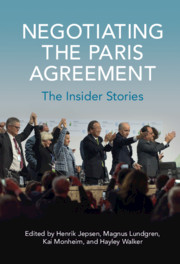Book contents
- Negotiating the Paris Agreement
- Negotiating the Paris Agreement
- Copyright page
- Contents
- Figure
- Editors
- Contributors
- Acknowledgments
- Foreword
- 1 Introduction
- 2 The Paris Negotiations: Background and Context
- 3 The French COP 21 Presidency
- 4 Mission: Adoption with Ovations: The Contribution of the UNFCCC Secretariat to the Achievement of the Paris Agreement
- 5 The Paris Agreement and China’s Imprint
- 6 The EU’s Role in the Paris Agreement
- 7 The United States: Interesting Processes and Techniques Lined the Road to Paris
- 8 COP 21 – Complaints and Negotiation: The Role of the Like-Minded Developing Countries Group (LMDC) and the Paris Agreement
- 9 The Staircase of Paris
- 10 The Battle for Small Island Developing States
- 11 The High Ambition Coalition
- 12 The Power of Civil Society
- 13 Business: Creating the Context
- 14 Why Did They Finally Reach Agreement?
- 15 Conclusion: The Landscape of Multilateral Agreement in Paris and Beyond
- Afterword
- Appendix: The Paris Agreement
- References
- Index
11 - The High Ambition Coalition
Published online by Cambridge University Press: 24 September 2021
- Negotiating the Paris Agreement
- Negotiating the Paris Agreement
- Copyright page
- Contents
- Figure
- Editors
- Contributors
- Acknowledgments
- Foreword
- 1 Introduction
- 2 The Paris Negotiations: Background and Context
- 3 The French COP 21 Presidency
- 4 Mission: Adoption with Ovations: The Contribution of the UNFCCC Secretariat to the Achievement of the Paris Agreement
- 5 The Paris Agreement and China’s Imprint
- 6 The EU’s Role in the Paris Agreement
- 7 The United States: Interesting Processes and Techniques Lined the Road to Paris
- 8 COP 21 – Complaints and Negotiation: The Role of the Like-Minded Developing Countries Group (LMDC) and the Paris Agreement
- 9 The Staircase of Paris
- 10 The Battle for Small Island Developing States
- 11 The High Ambition Coalition
- 12 The Power of Civil Society
- 13 Business: Creating the Context
- 14 Why Did They Finally Reach Agreement?
- 15 Conclusion: The Landscape of Multilateral Agreement in Paris and Beyond
- Afterword
- Appendix: The Paris Agreement
- References
- Index
Summary
Farhana Yamin, who advised the Marshall Islands, recounts why and how the High Ambition Coalition (HAC) was formed. Born out of the diplomatic disaster of COP 15 in 2009, where progressive countries had been “stuck in silos within their own coalitions”, the coalition grew in the context of the Cartagena Dialogue (CD) and the Climate Vulnerables Forum and was finally announced as “the HAC” in Paris. Representing a majority of parties, highly vulnerable countries, as well as major emitters, the coalition allowed for a Paris outcome that was more than just the lowest common denominator. Testifying to the HAC’s success, the Agreement came to include key demands of the vulnerable countries that had shaped it, including a temperature goal of 1.5°C. Yamin highlights the role of resources, networks, and relationships, which were formed at informal gatherings such as those in the CD. Assessing the overall HAC experience and impact, Yamin describes the demise of the HAC after COP 21 resulting from the failure of the EU and others to deliver or the election of Trump. She argues that the HAC was a time-bound strategic feature and that “next time there will be a different way of doing it”.
- Type
- Chapter
- Information
- Negotiating the Paris AgreementThe Insider Stories, pp. 216 - 244Publisher: Cambridge University PressPrint publication year: 2021
- 5
- Cited by

